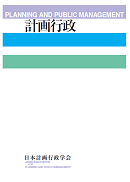Volume 39, Issue 1
Displaying 1-20 of 20 articles from this issue
- |<
- <
- 1
- >
- >|
Sustainability in the Contracting Society
Introductory Remarks
-
2016Volume 39Issue 1 Pages 1-2
Published: February 15, 2016
Released on J-STAGE: June 03, 2022
Download PDF (528K)
-
2016Volume 39Issue 1 Pages 3-4
Published: February 15, 2016
Released on J-STAGE: June 03, 2022
Download PDF (579K) -
2016Volume 39Issue 1 Pages 5-8
Published: February 15, 2016
Released on J-STAGE: June 03, 2022
Download PDF (737K)
Key Note Address
-
2016Volume 39Issue 1 Pages 9-13
Published: February 15, 2016
Released on J-STAGE: June 03, 2022
Download PDF (769K)
Symposium
-
2016Volume 39Issue 1 Pages 14-20
Published: February 15, 2016
Released on J-STAGE: June 03, 2022
Download PDF (734K)
Workshops
-
2016Volume 39Issue 1 Pages 21-23
Published: February 15, 2016
Released on J-STAGE: June 03, 2022
Download PDF (700K)
Scholarship Award
-
2016Volume 39Issue 1 Pages 24
Published: February 15, 2016
Released on J-STAGE: June 03, 2022
Download PDF (571K) -
2016Volume 39Issue 1 Pages 25
Published: February 15, 2016
Released on J-STAGE: June 03, 2022
Download PDF (570K) -
2016Volume 39Issue 1 Pages 26
Published: February 15, 2016
Released on J-STAGE: June 03, 2022
Download PDF (667K) -
2016Volume 39Issue 1 Pages 26
Published: February 15, 2016
Released on J-STAGE: June 03, 2022
Download PDF (667K) -
2016Volume 39Issue 1 Pages 27
Published: February 15, 2016
Released on J-STAGE: June 03, 2022
Download PDF (666K) -
2016Volume 39Issue 1 Pages 27
Published: February 15, 2016
Released on J-STAGE: June 03, 2022
Download PDF (666K) -
2016Volume 39Issue 1 Pages 28
Published: February 15, 2016
Released on J-STAGE: June 03, 2022
Download PDF (653K) -
2016Volume 39Issue 1 Pages 28
Published: February 15, 2016
Released on J-STAGE: June 03, 2022
Download PDF (653K)
Research Paper
-
2016Volume 39Issue 1 Pages 32-39
Published: February 15, 2016
Released on J-STAGE: June 03, 2022
Download PDF (4022K) -
2016Volume 39Issue 1 Pages 40-48
Published: February 15, 2016
Released on J-STAGE: June 03, 2022
Download PDF (2737K) -
2016Volume 39Issue 1 Pages 49-57
Published: February 15, 2016
Released on J-STAGE: June 03, 2022
Download PDF (2219K)
Local and Regional Planning
-
2016Volume 39Issue 1 Pages 58-61
Published: February 15, 2016
Released on J-STAGE: June 03, 2022
Download PDF (1030K)
Book Review
-
2016Volume 39Issue 1 Pages 62
Published: February 15, 2016
Released on J-STAGE: June 03, 2022
Download PDF (526K) -
2016Volume 39Issue 1 Pages 63
Published: February 15, 2016
Released on J-STAGE: June 03, 2022
Download PDF (553K)
- |<
- <
- 1
- >
- >|
